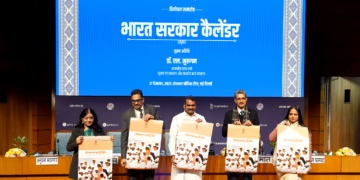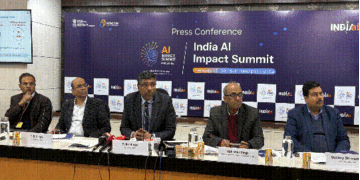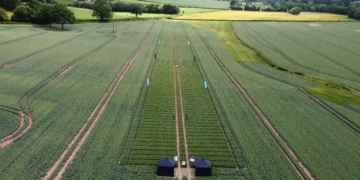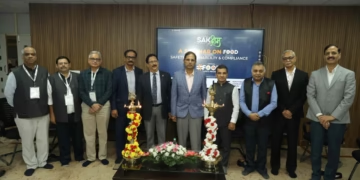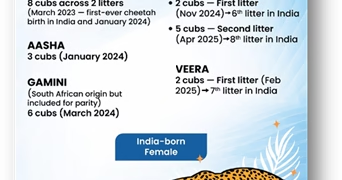Introduction
 Food plays a crucial role not only in human survival but also in shaping environmental sustainability. It impacts biodiversity, water use, and contributes to greenhouse gas emissions. Sustainable food choices are becoming increasingly important as we aim to balance human health with the health of our planet.
Food plays a crucial role not only in human survival but also in shaping environmental sustainability. It impacts biodiversity, water use, and contributes to greenhouse gas emissions. Sustainable food choices are becoming increasingly important as we aim to balance human health with the health of our planet.
Studies increasingly show that our current food systems are straining the planet’s resources. Yet, amidst this challenge, there is a glimmer of hope. The WWF’s 2024 Living Planet Report highlights India’s food practices as a model of sustainability. Remarkably, if the world adopted India’s consumption habits, we would only need 0.84 of an Earth by 2050 to sustain global food production. This recognition positions India as a potential leader in the global movement towards environmentally responsible consumption.[1]
Indian Thali: Food for Sustainability
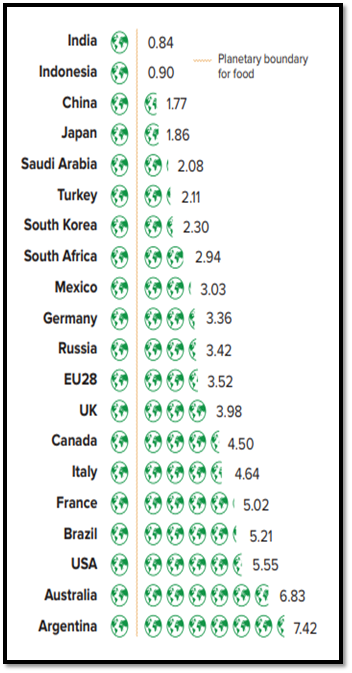
The traditional Indian diet, which is largely plant-based, stands out as an environmentally sustainable model. By relying on grains, pulses, lentils, and vegetables rather than resource-intensive animal products, the Indian diet uses fewer natural resources and emits fewer greenhouse gases.
According to the WWF report, if all countries followed India’s consumption patterns, the global demand for resources would be significantly lower. The report estimates that by 2050, the world would only need 0.84 of an Earth to sustain food production if India’s diet model were adopted worldwide.
The report specifically mentions India’s approach to sustaining global food production by 2050. It emphasizes traditional and resilient crops like millet through initiatives such as the National Millet Campaign.
India’s practices demonstrate how local cultural traditions can support healthier diets while reducing land use, restoring nature, and mitigating environmental impacts.
Shree Anna: India’s Millet Mission for Nutrition and Sustainability
Acknowledging millet’s nutritional benefits, the Indian government has taken significant steps by classifying it as a Nutri-Cereal. Further, by naming it Shree Anna, this miracle food has been given a new meaning and dimension.

In a bid to promote these ancient grains on a global stage, the United Nations declared 2023 as the International Year of Millets in March 2021. This milestone marked a pivotal moment for India, as the government strives to enhance millet productivity and transform food consumption patterns by incorporating these nutritious grains into everyday diets. To achieve this vision, various initiatives have been rolled out, including:
Centre of Excellence: The Indian Institute of Millets Research (IIMR) in Hyderabad serves as a Centre of Excellence, sharing best practices and research globally.
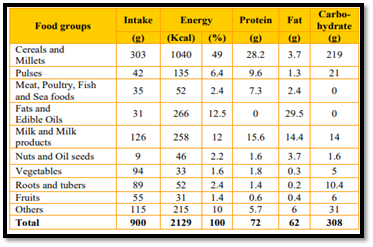
Global Promotion Initiatives: Hosted events like the G20 presidency initiatives, Millet Culinary Carnivals, International Trade Events, and ASEAN India Millet Festivals to promote millets worldwide.
Production Linked Incentive Scheme: The Ministry of Food Processing Industries approved a ₹800 crore scheme for millet-based products from 2022-23 to 2026-27.
Integration with Nutrition Schemes: Millets are included in the Poshan Abhiyan, and guidelines were revised to boost millet procurement under various government schemes.
Eat Right Campaign: The FSSAI promotes millets as part of a healthy diet and encourages government departments to include millet snacks at events.
Farmer Support: The Sub-Mission on Nutri-Cereals under the National Food Security Mission (NFSM) offers incentives for millet production across 28 states and 2 Union Territories. States have flexibility to promote millets under the Rashtriya Krishi Vikas Yojana (RKVY).
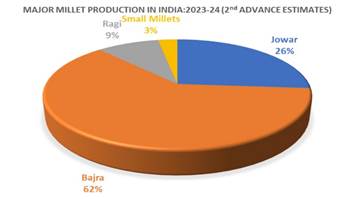
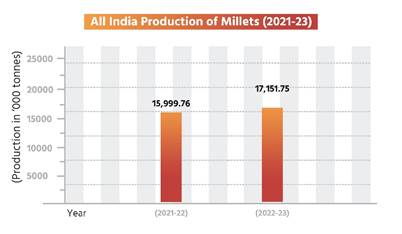
These comprehensive efforts reflect India’s commitment to enhancing the production, consumption, and global presence of millet. They showcase its nutritional and environmental benefits while promoting sustainable diets and responsible sourcing.
India Paving Way for Sustainable Farming
To enhance agricultural productivity and sustainability, the Union government, under the leadership of Prime Minister Shri Narendra Modi, is actively promoting climate-resilient farming. A key milestone in this effort is the introduction of 109 high-yielding, climate-resilient crop varieties across 32 field and horticultural crops. Additionally, the government has launched several initiatives aimed at encouraging sustainable farming practices. The government has implemented several initiatives to promote sustainable farming practices-
- National Mission for Sustainable Agriculture (NMSA): Part of India’s climate action plan, focusing on improving agriculture resilience through programs like Rainfed Area Development, On-Farm Water Management, and Soil Health Management.
- Organic Farming Promotion: Initiatives like Parampragat Krishi Vikas Yojana (PKVY) and the Mission Organic Value Chain Development (North East) encourage organic farming clusters, local organic brands (e.g., “Organic Uttarakhand”), and natural farming across states.
- Namami Gange Programme: Combines sustainable agriculture with efforts to rejuvenate the Ganga river, including afforestation on over 1.34 lakh hectares.
- Jaivik-Kheti Portal: An online platform where more than 6 lakh farmers can directly sell their organic products to consumers.
- Large Area Certification: The Indian government has recognized and certified regions that have a long-standing tradition of organic farming, including the Andaman & Nicobar Islands, Ladakh, and Lakshadweep, as fully organic.
- Climate-Resilient Agriculture: Through the National Innovations in Climate Resilient Agriculture (NICRA), India has developed over 2,000 crop varieties resistant to climate stress.
- Horticulture Development: Under the Mission for Integrated Development of Horticulture, there has been a significant increase in the area for horticultural crops, organic farming, and rejuvenation of old orchards.[2]
Key Highlights of Global Food System
The WWF Living Planet Report 2024 highlights that the food system is the most significant driver of habitat loss and degradation globally. Other major threats include overexploitation, invasive species, pollution, and climate change.
- Biodiversity Loss: The global food system is the leading cause of habitat loss, using 40% of all habitable land with a staggering 71% allocated for livestock grazing. It is responsible for over a quarter of global greenhouse gas emissions. Further, this heavy reliance on livestock has significantly declined crop diversity, resulting in only 10 major crops providing 83% of global food calories.
- Food Waste: An estimated 30-40% of all food produced is never consumed, accounting for a significant portion of global environmental impact, including 4.4% of greenhouse gas emissions.
- Nutritional Deficiency and Obesity: Despite record food production, the system fails to deliver adequate nutrition. Nearly 735 million people go to bed hungry, while obesity rates are rising. This paradox highlights inefficiencies and inequities in the current system.
- Unsustainable Practices: The food system’s hidden environmental and health costs are estimated to be between $10-15 trillion annually, undermining long-term food security and the ability to sustain future generations.
- Freshwater Depletion: Agriculture uses 70% of global freshwater withdrawals, contributing to declining groundwater levels and river flows.
- Fisheries Under Pressure: Over 90 million tons of seafood are harvested annually, feeding over 3 billion people, but 37.7% of marine fish stocks are overfished. Overexploitation and climate change threaten marine ecosystem, pushing some regional fish populations toward collapse.
- Biodiversity Loss and Species Extinction: The global food system is a primary driver of biodiversity loss, with agriculture threatening over 80% of endangered terrestrial bird and mammal species. The decline in crop diversity and near extinction of pollinators jeopardizes agricultural productivity, posing a risk to food security.
Recognizing the adverse impact of unsustainable food consumption and production practices, the report calls for transformative changes in the food, energy, and finance systems to halt biodiversity loss. These changes include scaling up nature-positive food production, transitioning to renewable energy sources, and redirecting financial resources away from environmentally harmful activities.











